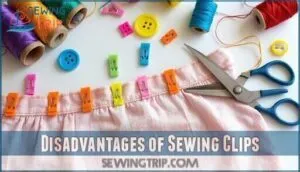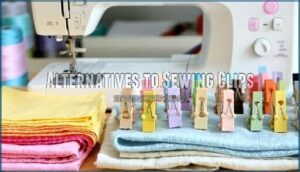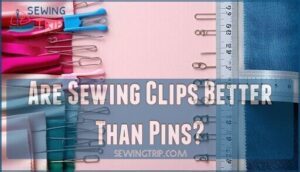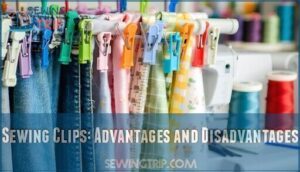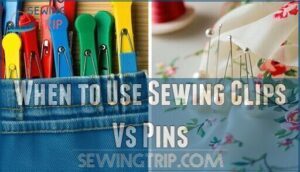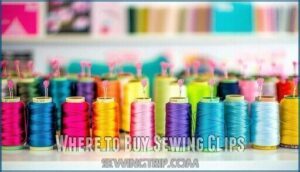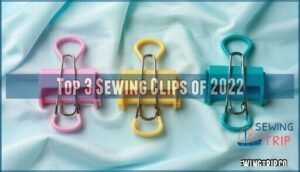This site is supported by our readers. We may earn a commission, at no cost to you, if you purchase through links.
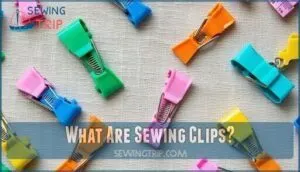
They’re shaped like tiny clothespins with flat bases and rounded tops, making them perfect for bulky fabrics, leather, or vinyl that pins can’t handle.
You’ll find them invaluable when working with multiple layers, binding quilts, or hemming thick materials.
Unlike pins, they won’t leave permanent holes in delicate fabrics or slip out of slippery materials.
They’re also safer since there’s no sharp point to poke your fingers.
Most sewers keep a variety pack handy because they come in different sizes for various fabric weights.
The best part is that they grip firmly without distorting your fabric’s shape, giving you precise control over your seams.
There’s more to choosing the right clips than meets the eye, and having a variety pack can provide better results with different fabrics.
Table Of Contents
- Key Takeaways
- Advantages of Sewing Clips
- Disadvantages of Sewing Clips
- Alternatives to Sewing Clips
- What Are Sewing Clips?
- What Are Sewing Clips Used For?
- Are Sewing Clips Better Than Pins?
- Sewing Clips: Advantages and Disadvantages
- How to Use Sewing Clips
- When to Use Sewing Clips Vs Pins
- Where to Buy Sewing Clips
- Top 3 Sewing Clips of 2022
- Frequently Asked Questions (FAQs)
- Conclusion
Key Takeaways
- You’ll protect delicate fabrics – Sewing clips grip without piercing, preventing holes in leather, vinyl, and silk that pins would damage permanently.
- You’ll handle thick materials easily – These clips secure multiple layers of denim, canvas, and quilting batting that would bend or break traditional pins.
- You’ll work safer and faster – No finger pricks or sharp points around children, plus clips attach quicker than pins and won’t slip out during sewing.
- You’ll get better alignment control – Flat bases slide smoothly under presser feet without distorting fabric position, giving you precise seam control throughout your project.
Advantages of Sewing Clips
Sewing clips revolutionize your fabric work by offering superior fabric protection compared to traditional pins.
Transform your sewing with clips that grip without piercing—perfect for delicate fabrics and thick layers alike.
These versatile sewing accessories excel at holding thick fabrics like denim, canvas, and multiple quilt layers without piercing or damaging delicate materials such as leather, vinyl, or silk.
Enhanced safety ranks among their top advantages – you’ll eliminate finger pricks and reduce injury prevention concerns around children and pets.
Unlike pins, these sewing notions won’t bend under pressure or create snags in your precious fabrics.
Precision sewing becomes effortless with clips’ flat bases, which slide smoothly under presser feet without distorting fabric alignment.
They’re faster to attach than pins and feature bright colors for easy visibility.
These essential sewing supplies provide stronger grip strength, preventing fabric shifting during critical seam construction.
For quilters and garment makers working with challenging materials, sewing clips deliver the reliability and control you need to achieve professional results every time.
Disadvantages of Sewing Clips
Every coin has two sides, and sewing clips aren’t perfect. Placement precision takes a hit compared to sewing pins, especially when marking dart lines or intricate details. You’ll notice fabric shifting can occur during attachment, particularly around curves and corners where clips might slip or move your material out of alignment.
Bulkiness issues create their own challenges. These clips weigh more than pins and can stretch or distort lightweight fabrics. Their chunky design sometimes gets in the way during detailed work, making them less suitable for delicate fabrics that need gentle handling.
Limited tasks define another drawback. Unlike pins, you can’t sew over clips or use them for middle-of-fabric positioning. They’re strictly edge tools, requiring removal before reaching your presser foot. You’ll need more clips to cover the same area that pins would handle, and the initial investment costs more than traditional pins, which is a significant consideration for initial investment costs and the fact that clips are strictly edge tools.
Alternatives to Sewing Clips
Budget-friendly alternatives exist when sewing clips aren’t available. You’ll find creative solutions using everyday household items that work surprisingly well.
Don’t let missing sewing clips stop your project. Common office supplies and household items can step in as effective fabric clips. These makeshift clamps won’t match specialized sewing clips perfectly, but they’ll get the job done.
Here are practical sewing clip alternatives you can try:
- Binder clips – Large ones handle thick fabric layers with strong grip, perfect for heavy materials
- Laundry pegs – Wooden clothespins with rubber tips provide secure hold without fabric damage
- Hair clips – Small plastic clips work well for lightweight fabrics and delicate materials
- DIY clips – Bent paper clips create custom makeshift clamps for specific project needs
These sewing pin alternatives from office supplies won’t replace professional fabric clips entirely, but they’re lifesavers during late-night sewing sessions. Each option offers different grip strength and opening width, so match your choice to your fabric weight and project requirements.
What Are Sewing Clips?
You’ve explored alternatives, now let’s get to the heart of what makes these little powerhouses tick. Sewing clips are spring-loaded clamps designed specifically for fabric work, resembling miniature bulldogs with rubber-padded jaws that grip without damage.
These sewing tools originated as fabric clips to solve pin-related problems in quilting and garment construction. Clip materials typically include durable plastic bodies with rubber or silicone grips, though metal versions exist for heavy-duty applications.
Clip sizes range from tiny 1/4-inch models for delicate work to large 2-inch versions for thick materials. Clip variations include color-coded sets, measuring guides, and specialty shapes. Clip ergonomics focus on comfortable finger grips and smooth operation.
| Feature | Benefit |
|---|---|
| Spring-loaded mechanism | Consistent pressure without hand fatigue |
| Rubber-padded jaws | Prevents fabric damage and slipping |
| Flat base design | Smooth feeding through machine foot |
Quilting clips excel at holding multiple layers, while standard sewing supplies work perfectly for everyday projects. These sewing tools transform your workflow from pin-pricking frustration to smooth, efficient crafting.
What Are Sewing Clips Used For?
These versatile sewing tools serve countless purposes in your crafting toolkit.
From endless possibilities to professional results – sewing clips unlock your creative potential.
You’ll use sewing clips for fabric holding when working with multiple layers, ensuring pieces stay perfectly aligned throughout your project.
They excel at seam alignment, gripping edges without distorting materials like traditional pins might.
Clip sewing works particularly well with delicate fabrics such as silk, chiffon, or lace, where pins could leave permanent marks or snag threads.
For thick materials like denim, canvas, or leather, these fabric clamps provide the strong grip needed to manage hefty layers that would bend ordinary pins.
Quilting projects benefit tremendously from using sewing clips, especially when binding edges or securing batting between fabric layers.
You can position these sewing tools right up to your machine’s presser foot, then remove them as you sew.
Whether you’re constructing bags, hemming curtains, or assembling garments, these clips keep everything in place while you work, making them an essential part of your crafting toolkit.
Are Sewing Clips Better Than Pins?
Which tool delivers better results for your sewing projects? The answer depends on your specific needs and fabric types.
Sewing clips offer significant advantages for thick materials like denim, fleece, or multiple quilt layers. Their flat bases prevent fabric shifting during feeding, while their non-piercing design eliminates fabric damage on vinyl, leather, or delicate textiles. The ergonomic benefits make them easier to grip, and their speed comparison shows faster application than traditional pins.
However, pins excel in accuracy comparison for precise work. They’re better for detailed pattern markings, dart placement, and lightweight fabrics where clips might add unwanted weight or cause stretching.
Project suitability determines the best choice. Clips work well for bag-making, quilting, and binding applications. Pins suit garment construction requiring exact placement. The disadvantages of clips include their bulk and removal requirements before reaching the presser foot.
Many sewists keep both tools handy, selecting based on fabric weight, precision needs, and safety concerns. Consider your project’s specific requirements when choosing between these essential sewing tools. For instance, clips are particularly useful because they avoid fabric holes, which is a significant advantage in certain sewing projects.
Sewing Clips: Advantages and Disadvantages
Anyone can improve their sewing experience by understanding both the strengths and limitations of sewing clips. These spring-loaded tools offer distinct advantages over traditional sewing pins, though they’re not perfect for every situation.
Key advantages of sewing clips:
- No Fabric Damage – Clips don’t pierce materials, making them ideal for leather, vinyl, and delicate fabrics where pins would leave permanent holes
- Enhanced Safety – You’ll eliminate finger pricks and reduce injury risks, especially important when working around children
- Superior Hold – Clips grip multiple thick layers securely without bending or slipping like pins often do
- Clip Precision – Built-in seam allowance markings help guarantee accurate measurements every time
However, sewing clips have notable disadvantages. Their Bulkiness Issues can stretch lightweight fabrics and make them unsuitable for fine detail work. Cost Analysis shows clips require higher initial investment than pins.
They’re also easier to handle than pins, especially for those with dexterity issues. Best Applications include quilting and bag-making, but they lack the precision needed for darts or intricate pattern work.
How to Use Sewing Clips
Mastering sewing clips transforms your fabric handling from frustrating to effortless. These colorful tools grip layers securely without piercing delicate fabrics or leaving holes in thick materials.
Here’s your step-by-step guide to using sewing clips effectively:
- Clip Placement: Position clips along fabric edges at 1-2 inch intervals, aligning with your seam allowance markings for consistent results.
- Curve Clipping: Space clips closer together on curves and corners to maintain precise alignment and prevent fabric shifting during sewing.
- Thick Fabrics: Use extra-strong clips for heavy materials like canvas or multiple quilt layers, ensuring they grip securely without slipping.
- Delicate Fabrics: Choose clips with silicone tips for fragile materials that might snag or tear with traditional pins.
- Removal Timing: Remove clips just before your presser foot reaches them during sewing to prevent machine damage.
The flat base design allows smooth fabric feeding while maintaining perfect edge alignment throughout your sewing techniques. Unlike pins, clips eliminate concerns about avoiding needle damage.
When to Use Sewing Clips Vs Pins
Choosing between sewing clips and pins depends on fabric type, project complexity, and accuracy needs.
Clips excel with thick fabrics, leather, and vinyl where pins can’t penetrate or would leave holes. Their holding power suits binding and bulky seams.
Pins offer precision for delicate fabrics and detailed work like darts or elastic attachment. User preference matters too—clips provide safety and speed, while pins deliver control.
| Factor | Use Clips | Use Pins |
|---|---|---|
| Fabric Type | Thick fabrics, leather, vinyl | Delicate fabrics, lightweight materials |
| Task Precision | General construction, binding | Detailed alignment, darts, elastic |
| Holding Power | Multiple layers, bulky seams | Single layers, precise placement |
| Safety Priority | Beginners, children present | Experienced sewers, careful handling |
Where to Buy Sewing Clips
Several online retailers and local fabric stores offer sewing clips, craft clips, and wonder clips for your quilting supplies needs.
Amazon provides the widest selection, with 100-piece sets starting around $6 from brands like WAWAK, though quality varies.
Madam Sew offers premium multicolor packs with 50 regular clips for $12 and fast U.S. shipping.
Local fabric stores like Hobby Lobby stock smaller 10-piece Wonder Clip packs in their notion sections, perfect for trying before buying bigger quantities.
Online retailers like WAWAK and Love Sew specialize in bulk sewing supplies with competitive pricing.
Consider purchasing sewing clips in bulk for larger projects.
Clover USA commands premium prices at $34.95 for 50 clips but delivers industry-standard quality.
Craft marketplaces offer discount options, though brand comparison reveals significant quality differences between budget and premium clips for your projects.
Top 3 Sewing Clips of 2022
You’ll want to choose clips that match your specific projects and budget. Here are two standout options that earned top marks in 2022 for their reliability and versatility.
Mini Wonder Clips Multicolour Set
Precision meets portability with the Mini Wonder Clips Multicolour Set. These compact sewing clips feature a narrow 1" x 1/4" x 1/8" point that’s perfect for tight corners and small sections where regular clips won’t fit.
- Color Coding: Bright multicolored design helps you organize different fabric layers and prevents clips from disappearing into your workspace
- Clip Size: Compact dimensions make these small sewing clips ideal for delicate work without overwhelming lightweight fabrics
- Storage Ideas: The 20-piece set comes organized for easy transport and quick access during quilting sessions
Their curved top and flat bottom design allows smooth feeding under your presser foot. You’ll appreciate how these wonder clips grip multiple layers of slippery materials like vinyl and silk without leaving marks.
More information about purchasing these clips can be found online.
Colorful Sewing Clips 100-Pack
When you’re stocking up for extensive projects, this 100-pack delivers unbeatable bulk clip value at under $8.
These colorful sewing clips feature measurement markings for precise seam alignment and accommodate multiple fabric layers with their wide opening. The bright multicolored design provides excellent color organization and visibility during sewing tasks.
You can find a variety of assorted sewing clips for different needs.
| Feature | Benefit |
|---|---|
| Bulk quantity (100 clips) | Cost-effective for large projects |
| Measurement markings | Precise seam alignment guidance |
| Wide opening (1.2 cm) | Handles thick layers and wadding |
While the lighter plastic construction may impact clip longevity compared to premium brands, these plastic sewing clips offer solid project suitability for quilting and bag making.
The storage solutions improve with their tin container, keeping your best sewing clips organized and accessible.
Frequently Asked Questions (FAQs)
What is the purpose of sewing clips?
Sewing clips hold fabric layers together temporarily during sewing projects.
You’ll use them to secure thick materials, delicate fabrics, or multiple layers without piercing holes like pins do, ensuring accurate alignment.
What is the difference between a pin and a clip?
Consider quilting leather – pins leave permanent holes, but clips grip firmly without damage.
Pins pierce fabric with sharp points, potentially leaving marks or holes.
Clips use spring-loaded jaws with rubber pads to hold layers securely without penetrating material, making them ideal for delicate or thick fabrics.
How do you clean sewing clips properly?
Clean your sewing clips with warm soapy water and a soft brush to remove fabric fibers and lint. Rinse thoroughly and dry completely before storing to prevent damage.
What sizes do sewing clips come in?
Like choosing the right paintbrush for different canvas textures, you’ll find sewing clips in small, medium, and large sizes to match your fabric’s weight and project needs, ensuring perfect grip every time.
Can sewing clips break or wear out?
Yes, sewing clips can break or wear out over time.
The spring mechanism may weaken, rubber pads can deteriorate, and plastic parts might crack with heavy use, making them less effective, due to the heavy use.
How many clips do I need for projects?
A quilter working on a king-size quilt needs about 40-50 clips. For most projects, you’ll need 10-20 clips depending on fabric thickness and edge length. Bulky materials require more clips.
Are there specialty clips for specific fabrics?
Most sewing clips work across different fabrics, but some feature specialized designs.
You’ll find clips with gentler grips for delicate silks, extra-strong holds for thick leather, and curved shapes for binding curved seams effectively, which utilize curved shapes.
Conclusion
Absolutely revolutionary for modern sewers, sewing clips have transformed how we handle fabric preparation.
These versatile tools eliminate the frustration of pins slipping from thick materials or leaving holes in delicate fabrics.
When you understand what sewing clips are and their applications, you’ll discover they’re essential for achieving professional results with leather, vinyl, quilting, and multi-layer projects.
While they can’t replace pins entirely, they’re invaluable additions to your sewing toolkit, offering superior grip and safety for challenging materials.

